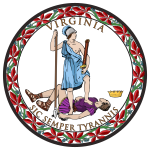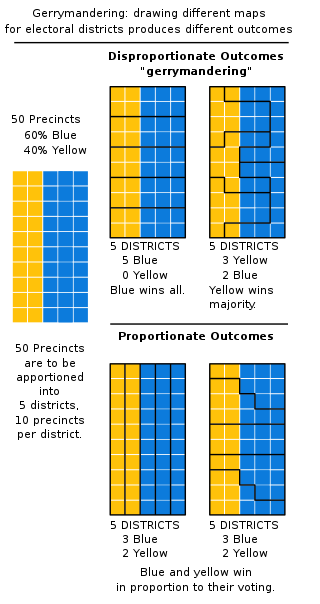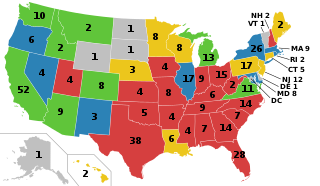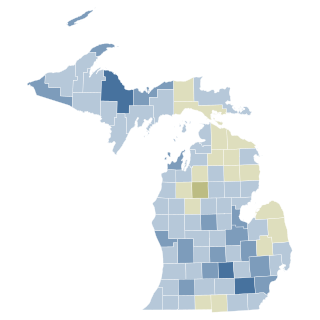Overview of redistricting in Virginia
Redistricting has been a controversial topic in Virginia due to allegations of gerrymandering. In the 2017 Virginia General Assembly, all of the redistricting reform bills were killed. [1]
| Elections in Virginia |
|---|
 |
Redistricting has been a controversial topic in Virginia due to allegations of gerrymandering. In the 2017 Virginia General Assembly, all of the redistricting reform bills were killed. [1]
The Virginia Constitution states:
"Members of the House of Representatives of the United States and members of the Senate and of the House of Delegates of the General Assembly shall be elected from electoral districts established by the General Assembly. Every electoral district shall be composed of contiguous and compact territory and shall be so constituted as to give, as nearly as is practicable, representation in proportion to the population of the district. The General Assembly shall reapportion the Commonwealth into electoral districts in accordance with this section in the year 2011 and every ten years thereafter." [2]
The Republican Party lost one of its seats in Congress when a federal court redrew Virginia's 4th congressional district. A suit claimed the district had been racially gerrymandered to give an advantage to white Republicans. The ruling in that case found that the General Assembly in 2012 unconstitutionally packed too many black voters into Bobby Scott's district, weakening the clout of blacks in nearby districts. [3] This ruling allowed Democrat Donald McEachin to represent the 4th District in the newly convened U.S. House of Representatives. [4]
Delegate Mark L. Cole noted that even without gerrymandering, political polarization will exist because of the stark political differences between urban and rural areas, which makes drawing competitive districts impossible in some regions of the state. [5]
On 1 March 2017, the U.S. Supreme Court sent a case involving 12 Virginia House of Delegates districts back to a lower court to rule on 11 of those districts. [6] Richmond Circuit Court Judge W. Reilly Marchant ruled that the constitutionality of the map was "fairly debatable" and therefore upheld it. [7] In June 2018, the U.S. District Court for the Eastern District of Virginia found that the 11 districts unconstitutionally concentrated black voters, depriving them of representation. [8] The Court gave the Virginia legislature until October 30, 2018, to submit a new map, but the Republican-majority Assembly was unable to agree on a map that would also be supported by Democratic Governor Ralph Northam, and the Court instead appointed University of California, Irvine political science professor Bernard Grofman to serve as special master to oversee the redistricting process. [8]
Article II, section 6 on apportionment states, "Members of the ... Senate and of the House of Delegates of the General Assembly shall be elected from electoral districts established by the General Assembly. Every electoral district shall be composed of contiguous and compact territory and shall be so constituted as to give, as nearly as is practicable, representation in proportion to the population of the district." [9] The Redistricting Coalition of Virginia proposes either an independent commission or a bipartisan commission that is not polarized. Member organizations include the League of Women Voters of Virginia, AARP of Virginia, OneVirginia2021, the Virginia Chamber of Commerce and the Virginia Organizing Project. [10] Governor Bob McDonnell's Independent Bipartisan Advisory Commission on Redistricting for the Commonwealth of Virginia made its report on April 1, 2011. It made two recommendations for each state legislative house that showed maps of districts more compact and contiguous than those adopted by the General Assembly. [11]
In 2011, the Virginia College and University Redistricting Competition was organized by Professors Michael McDonald of George Mason University and Quentin Kidd of Christopher Newport University. About 150 students on sixteen teams from thirteen schools submitted plans for legislative and U.S. congressional districts. They created districts more compact than the General Assembly's efforts. The "Division 1" maps conformed with the Governor's Executive Order, and did not address electoral competition or representational fairness. In addition to the criteria of contiguity, equipopulation, the federal Voting Rights Act and communities of interest in the existing city and county boundaries, "Division 2" maps in the competition did incorporate considerations of electoral competition and representational fairness. Judges for the cash award prizes were Thomas Mann of the Brookings Institution and Norman Ornstein of the American Enterprise Institute. [12]
In January 2015, Republican State Senator Jill Holtzman Vogel of Winchester and Democratic State Senator Louise Lucas of Portsmouth sponsored a Senate Joint Resolution to establish additional criteria for the Virginia Redistricting Commission of four identified members of political parties, and three other independent public officials. The criteria began with respecting existing political boundaries, such as cities and towns, counties and magisterial districts, election districts and voting precincts. Districts are to be established on the basis of population, in conformance with federal and state laws and court cases, including those addressing racial fairness. The territory is to be contiguous and compact, without oddly shaped boundaries. The commission is prohibited from using political data or election results to favor either political party or incumbent. It passed with a two-thirds majority of 27 to 12 in the Senate, and was then referred to committee in the House of Delegates. [13]
In 2015, at Vesilind v. Virginia State Board of Elections in a Virginia state court, plaintiffs sought to overturn the General Assembly's redistricting in five House of Delegate and six state Senate districts as violations of both the Virginia and U.S. Constitutions because they failed to represent populations in "continuous and compact territory". [14]
The Virginia General Assembly passed HJ 615 [15] in 2019 and SJ 18 [16] in 2020 to amend the state constitution to form a redistricting commission for the 2021 redistricting process. In accordance with Virginia's process for amending the state constitution, this proposed amendment had to pass through the General Assembly in two, concurrent years before being passed on to Virginia voters, who will vote on this referendum in November 2020. The amendment, if added to the Virginia Constitution, will create a sixteen-member commission, composed of eight citizens, two Senate Democrats, two Senate Republicans, two House Democrats, and two House Republicans, to redistrict Virginia, instead of the General Assembly. It will also cement requirements for commission transparency and historic civil rights protections for racial and ethnic minorities in the Virginia Constitution. [17] If the commission cannot agree or if the General Assembly rejects the commission's map twice, the Virginia Supreme Court will redraw the districts in accordance with existing standard, likely with the help of a Special Master. The amendment passed with 65.69% of the vote.

In representative democracies, gerrymandering is the political manipulation of electoral district boundaries with the intent to create undue advantage for a party, group, or socioeconomic class within the constituency. The manipulation may involve "cracking" or "packing". Gerrymandering can also be used to protect incumbents. Wayne Dawkins describes it as politicians picking their voters instead of voters picking their politicians.

The Virginia General Assembly is the legislative body of the Commonwealth of Virginia, the oldest continuous law-making body in the Western Hemisphere, the first elected legislative assembly in the New World, and was established on July 30, 1619. The General Assembly is a bicameral body consisting of a lower house, the Virginia House of Delegates, with 100 members, and an upper house, the Senate of Virginia, with 40 members. Senators serve terms of four years, and Delegates serve two-year terms. Combined, the General Assembly consists of 140 elected representatives from an equal number of constituent districts across the commonwealth. The House of Delegates is presided over by the Speaker of the House, while the Senate is presided over by the Lieutenant Governor of Virginia. The House and Senate each elect a clerk and sergeant-at-arms. The Senate of Virginia's clerk is known as the "Clerk of the Senate".
Redistricting in the United States is the process of drawing electoral district boundaries. For the United States House of Representatives, and state legislatures, redistricting occurs after each decennial census.

California is the most populous U.S. state; as a result, it has the most representation in the United States House of Representatives, with 52 Representatives. Each Representative represents one congressional district.

Virginia is currently divided into 11 congressional districts, each represented by a member of the United States House of Representatives. The death of Rep. Donald McEachin on November 28, 2022, left the 4th congressional district seat empty. Following the results of a special election to fill his seat on February 21, 2023, Jennifer McClellan made history by becoming Virginia's first black congresswoman.
Electoral reform in Virginia refers to efforts to change the electoral system in the Commonwealth of Virginia. Virginia has undergone much electoral change since its settling in 1607, many of which were required by federal legislation. However, it remains a relatively conservative state in this respect compared to California and others which have experimented with various alternative systems.

In the United States, a redistricting commission is a body, other than the usual state legislative bodies, established to draw electoral district boundaries. Generally the intent is to avoid gerrymandering, or at least the appearance of gerrymandering, by specifying a nonpartisan or bipartisan body to comprise the commission drawing district boundaries.
Vieth v. Jubelirer, 541 U.S. 267 (2004), was a United States Supreme Court ruling that was significant in the area of partisan redistricting and political gerrymandering. The court, in a plurality opinion by Justice Antonin Scalia and joined by Chief Justice William Rehnquist and Justices Sandra Day O'Connor and Clarence Thomas, with Justice Anthony Kennedy concurring in the judgment, upheld the ruling of the District Court in favor of the appellees that the alleged political gerrymandering was not unconstitutional. Subsequent to the ruling, partisan bias in redistricting increased dramatically in the 2010 redistricting round.
Mark Lanze Cole is an American politician of the Republican Party. From 2002 until 2022 he was a member of the Virginia House of Delegates. He represented the 88th district in the Virginia Piedmont, made up of parts of Fauquier, Spotsylvania and Stafford Counties, and the City of Fredericksburg, Virginia. Cole did not run for re-election in 2021.

The California Citizens Redistricting Commission is the redistricting commission for the State of California responsible for determining the boundaries of districts for the State Senate, State Assembly, and Board of Equalization. The commission was created in 2010 and consists of 14 members: five Democrats, five Republicans, and four from neither major party. The commission was created following the passage in November 2008 of California Proposition 11, the Voters First Act. The commissioners were selected in November and December 2010 and were required to complete the new maps by August 15, 2011.

Redistricting in Pennsylvania refers to the decennial process of redrawing state legislative and federal congressional districts in Pennsylvania.

The U.S. state of Arizona, in common with the other U.S. states, must redraw its congressional and legislative districts every ten years to reflect changes in the state and national populations. Redistricting normally follows the completion of the United States census, which is carried out by the federal government the first year of every decade; the most recent census took place in 2020. Historically, Arizona's legislature had control over the redistricting process. However, Proposition 106, passed in 2000, delegated the power to draw congressional and legislative boundaries to a bipartisan independent commission. The Arizona Independent Redistricting Commission (AIRC) comprises two Democrats, two Republicans, and one independent chair. County and local redistricting, which normally takes place along the same timeline as congressional and legislative redistricting, is carried out by the individual county and local governments rather than the AIRC.

Gerrymandering is the practice of setting boundaries of electoral districts to favor specific political interests within legislative bodies, often resulting in districts with convoluted, winding boundaries rather than compact areas. The term "gerrymandering" was coined after a review of Massachusetts's redistricting maps of 1812 set by Governor Elbridge Gerry noted that one of the districts looked like a mythical salamander.

The 2020 United States redistricting cycle is in progress following the completion of the 2020 United States census. In all fifty states, various bodies are re-drawing state legislative districts. States that are apportioned more than one seat in the United States House of Representatives are also drawing new districts for that legislative body.
OneVirginia2021 is an American civic non-profit organization founded to advocate for a non-partisan redistricting of the Commonwealth of Virginia. The group was founded in Charlottesville, Virginia in 2013 and is currently based in Richmond, Virginia.
Bethune-Hill v. Virginia State Bd. of Elections, 580 U.S. ___ (2017), was a case in which the United States Supreme Court evaluated whether Virginia's legislature – the Virginia General Assembly – violated the Equal Protection Clause of the Fourteenth Amendment to the United States Constitution by considering racial demographics when drawing the boundaries of twelve of the state's legislative districts.

Redistricting in North Carolina has been a controversial topic due to allegations and admissions of gerrymandering.

Michigan Proposal 18-2 was a ballot initiative approved by voters in Michigan as part of the 2018 United States elections. The proposal was created in preparation of the 2020 United States Census, to move control of redistricting from the state legislature to an independent commission. The commission consists of thirteen members selected randomly by the secretary of state: four affiliated with Democrats, four affiliated with Republicans, and five independents. Any Michigan voter can apply to be a commissioner, as long as they have not been, in the last six years, a politician or lobbyist. Proponents argued that Michigan's current districts are gerrymandered, giving an unfair advantage to one political party. Opponents argued that the process would give the secretary of state too much power over redistricting, and that the people on the commission would be unlikely to understand principles of redistricting. The proposal was approved with 61.28% of the vote.

Redistricting in Wisconsin is the process by which boundaries are redrawn for municipal wards, Wisconsin State Assembly districts, Wisconsin State Senate districts, and Wisconsin's congressional districts. Redistricting occurs—as in other U.S. states—once every decade, usually in the year after the decennial United States census. According to the Wisconsin Constitution, redistricting in Wisconsin follows the regular legislative process, it must be passed by both houses of the Wisconsin Legislature and signed by the Governor of Wisconsin—unless the Legislature has sufficient votes to override a gubernatorial veto. Due to legislative gridlock, however, it has become common for Wisconsin redistricting to be conducted by courts. The 1982, 1992, and 2002 legislative maps were each created by panels of United States federal judges.
The 2010 United States redistricting cycle took place following the completion of the 2010 United States census. In all fifty states, various bodies re-drew state legislative districts. States that are apportioned more than one seat in the United States House of Representatives also drew new districts for that legislative body. The resulting new districts were first implemented for the 2011 and 2012 elections.